Difference between PLC and DCS: Decoding the Automation Divide
This article delves into the key difference between PLC and DCS, providing a clear framework for choosing the appropriate technology for specific applications, and finally decoding the automation divide.
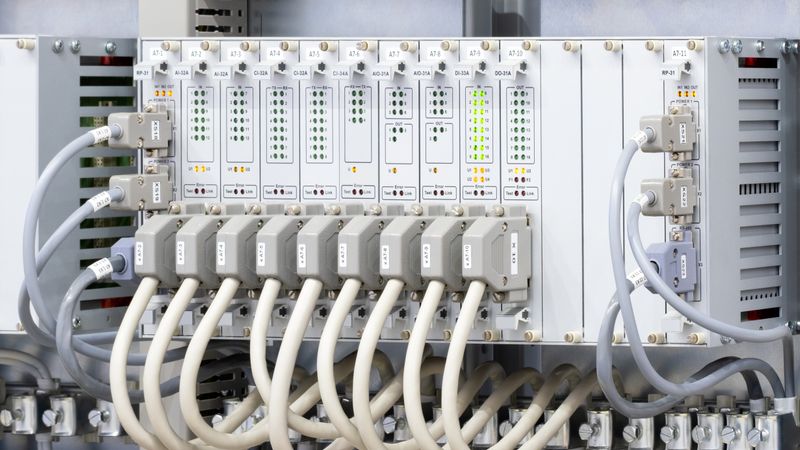
Communication protocols in industrial-based PLC automation system
Introduction
The difference between PLC and DCS is a cornerstone of industrial automation. Programmable Logic Controllers (PLC) are robust, compact devices designed for discrete control and rapid response in manufacturing environments. Distributed Control Systems (DCS), on the other hand, are sophisticated, integrated platforms built for continuous process control across large-scale operations. While both are instrumental in controlling processes, their applications, architectures, and complexities diverge significantly.
For engineers, understanding the difference between PLC and DCS is crucial for optimal design and implementation of automation solutions. Their choice can significantly impact the efficiency, scalability, and long-term operational costs of an industrial facility. This article delves into the core difference between PLC and DCS, providing clarity on when to employ each for optimal results, ultimately driving productivity and innovation in industrial control systems.
The Architectural Divide: PLC and DCS at Their Core
Centralized vs Distributed Control
The fundamental architectural difference between Programmable Logic Controllers (PLCs) and Distributed Control Systems (DCS) lies in their approach to control distribution. This distinction shapes their capabilities, scalability, and suitability for various industrial processes.
PLCs typically employ a centralized control architecture, where a single processor manages all control logic, input/output (I/O) processing, and communication. [1] This centralized approach allows for quick decision-making and rapid response times, making PLCs ideal for discrete manufacturing processes. While this architecture offers simplicity and cost-effectiveness for smaller, standalone systems, it can become a bottleneck as the system grows in complexity and scale.
In contrast, DCS utilizes a distributed control architecture, where multiple controllers are spread across a facility, each responsible for a specific process area. This distributed approach enhances system reliability, scalability, and redundancy. By distributing control and I/O, DCS systems can handle large-scale, complex processes with thousands of I/O points and multiple control loops.
To better understand the key structural differences between PLC and DCS architectures, consider the following comparison table:
| Feature | PLC | DCS |
| Control Distribution | Centralized | Distributed |
| Processor Configuration | Single or Redundant | Multiple, Distributed |
| I/O Handling | Local and Remote I/O | Distributed I/O Modules |
| Communication | Point to Point, Bus | Network-Based, Redundant |
| Scalability | Limited by Central Processor | Highly Scalable |
| Typical Application Size | Small to Medium | Medium to Large |
| Data Management | Local Data Storage | Centralized Historian |
| Human-Machine Interface | Basic HMI Capabilities | Advanced SCADA Integration |
| Typical Applications | Machine Control, Batch processes | Continuous Processes, Large Scale Plants |
Both architectures have their strengths and limitations. Let’s see the pros and cons for each:
PLC Architecture
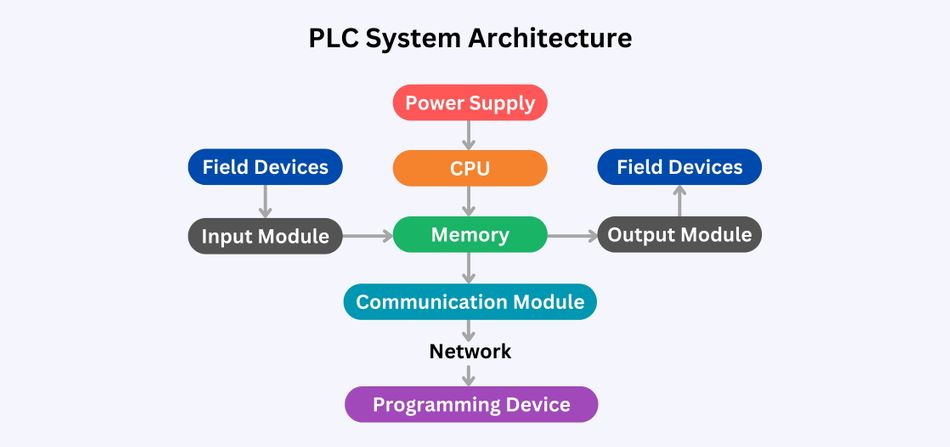
Pros:
Rapid Scan Times and Response: Efficient handling of high-speed I/O and control loops.
Intuitive Programming: User-friendly programming environments for faster development and troubleshooting.
Cost-Effective for Smaller Systems: Lower initial investment for standalone applications.
Rugged and Reliable: Designed for harsh industrial environments.
Cons:
Limited Scalability: Challenges in expanding to large-scale, complex processes.
Less Suitable for Complex Process Control: May struggle with intricate control algorithms and advanced process optimization.
Single Point of Failure Risk: Reliance on a central controller can impact system uptime.
Basic Data Handling: Limited capabilities for advanced data analysis and reporting.
DCS Architecture
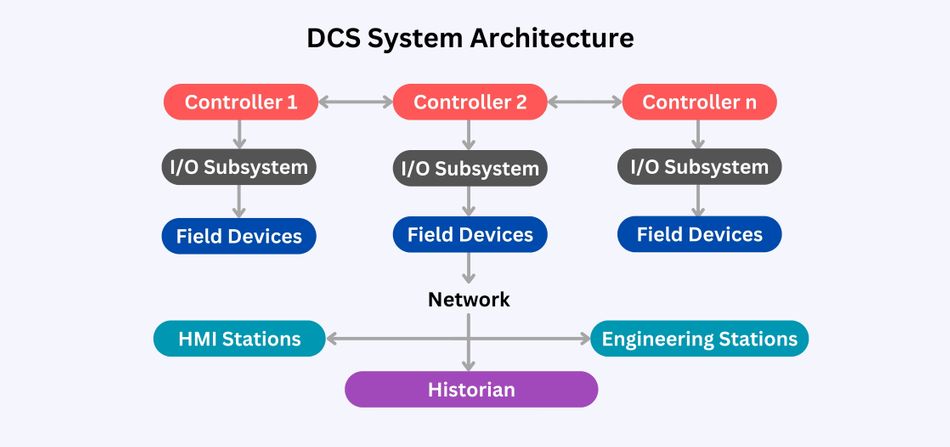
Pros:
Ideal for Large-Scale Processes: Handles complex, distributed systems with numerous control loops.
High Scalability and Flexibility: Easily expandable to accommodate growing process requirements.
Built-in Redundancy: Ensures continuous operation and fault tolerance.
Advanced Data Management: Comprehensive data acquisition, analysis, and visualization.
Cons:
Higher Initial Investment: Requires substantial upfront costs for hardware and software.
Slower Response Times for Discrete Control: Not optimal for high-speed, discrete applications.
Complex Engineering: Requires specialized expertise for system configuration and maintenance.
Vendor Lock-In: Tight integration with specific DCS platforms can limit flexibility.
While the lines between PLC and DCS have blurred with advancements in technology, understanding these architectural differences remains crucial for engineers when designing control systems. By carefully considering these factors, engineers can make informed decisions about the most suitable architecture for their specific application.
Recommended Reading: What is a Distributed Control System (DCS)?
Component Breakdown
Programmable Logic Controllers (PLCs) and Distributed Control Systems (DCS) are composed of distinct components that work together to provide effective control solutions. To further understand the differences between PLC and DCS systems, it's essential to examine their core components and see how they interact.
PLC Components:
Central Processing Unit (CPU): The brain of the PLC, executing the control program and managing system operations.
Power Supply: Provides necessary electrical power to the PLC and its components.
Input/Output (I/O) Modules: Interface between the PLC and field devices, converting signals between digital/analog and the PLC's internal format.
Communication Module: Enables connectivity with other PLCs, HMIs, and higher-level systems.
Memory: Stores the control program, data, and configuration settings.
Programming Device: Typically a computer is used to develop and upload the control program.
In a PLC system, the CPU repeatedly scans inputs, executes the control program, and updates outputs. The power supply ensures stable operation, while I/O modules handle signal conversion. The communication module facilitates data exchange with other systems, and the memory retains crucial information for continuous operation.
DCS Components:
Controllers: Distributed processors handling specific process areas or functions.
I/O Subsystems: Decentralized modules for signal acquisition and control output.
Human-Machine Interface (HMI): Operator workstations for process monitoring and control.
Engineering Workstations: Used for system configuration, programming, and maintenance.
Historian: Database for long-term storage of process data and events.
Communication Network: High-speed, redundant networks connecting all DCS components.
Field Devices: Sensors, actuators, and other process instruments.
In a DCS, controllers work autonomously within their assigned areas, communicating via the network. [2] I/O subsystems distribute data acquisition and control closer to the process. HMIs provide operators with real-time information and control capabilities, while engineering workstations allow for system-wide configuration. The historian captures and stores data for analysis and reporting.
Let’s understand it better using a diagram of PLC and DCS system structures:
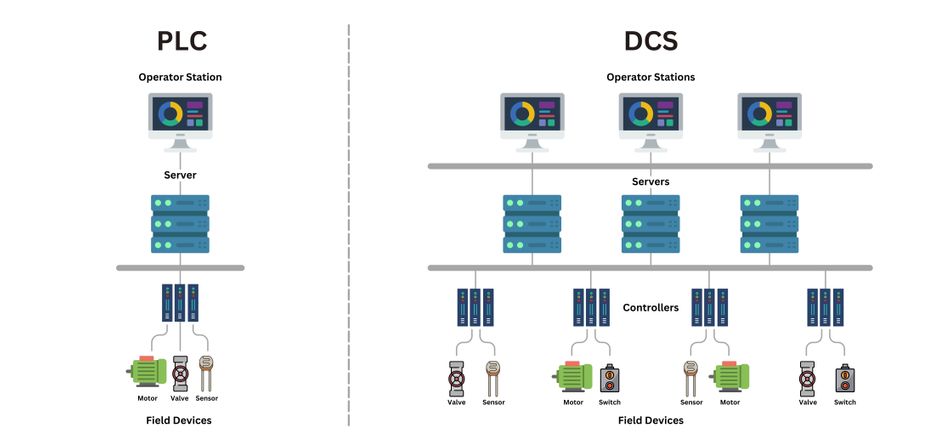
The diagrams above illustrate the centralized nature of PLC systems compared to the distributed architecture of DCS. In the PLC structure, all components are closely integrated with the central CPU. The DCS structure shows multiple controllers interconnected via a network, with distributed I/O subsystems and various workstations for different functions.
Recommended Reading: HMI Technologies: The Ultimate Guide to Human-Machine Interface Innovations
Functionality Face-off: Applications and Use Cases
PLC's Domain: Discrete Control and Machine Automation
Programmable Logic Controllers (PLCs) excel in environments that require precise, high-speed control of discrete processes and machine automation. These robust devices are usually well-suited for applications that involve sequential operations, repetitive tasks, and time-critical responses.

In manufacturing, PLCs are the backbone of assembly lines, controlling conveyor systems, robotic arms, and packaging machines. For example, in an automotive production line, PLCs orchestrate the precise movements of welding robots, ensuring consistent weld quality and timing. They also manage the sequencing of various assembly stations, coordinating the addition of components like doors, seats, and dashboards.
The food and beverage industry heavily relies on PLCs for packaging and bottling operations. A bottling plant might use PLCs to control the filling, capping, and labeling processes, ensuring accurate volumes, proper sealing, and correct label placement at high speeds. PLCs also manage clean-in-place (CIP) systems, crucial for maintaining hygiene standards in food processing equipment. [3]
In the pharmaceutical sector, PLCs play a vital role in tablet press machines, controlling the precise timing and pressure required for consistent medication production. They also manage environmental controls in cleanrooms, maintaining strict temperature, humidity, and air pressure parameters essential for drug manufacturing.
Material handling systems in warehouses and distribution centres often employ PLCs to control sorting and conveying equipment. For instance, in a large e-commerce fulfilment centre, PLCs manage complex networks of conveyors and sorting mechanisms. They direct packages to the correct loading docks based on destination information.
The plastics industry utilizes PLCs in injection molding machines, where they control the intricate timing of mold closing, plastic injection, cooling, and ejection. This precise control ensures consistent product quality and optimizes cycle times.
Key features that make PLCs suitable for these applications include:
Rapid scan times and fast execution speeds, enable real-time control of high-speed processes.
Modular design, allowing for easy expansion and customization to fit specific machine requirements.
Robust construction, capable of withstanding harsh industrial environments with extreme temperatures, vibrations, and electromagnetic interference.
Extensive I/O capabilities, supporting a wide range of digital and analog signals from various sensors and actuators.
Deterministic operation, ensuring consistent and predictable response times critical for precise machine control.
Built-in safety functions, such as emergency stop handling and safety interlocks, essential for machine automation.
Support for various communication protocols, enabling seamless integration with other industrial devices and systems.
User-friendly programming languages like ladder logic, make it accessible for technicians and engineers to develop and maintain control programs.
Hot-swappable components, allowing for quick replacements and minimizing downtime in production environments.
Compact form factor, ideal for installation in space-constrained control cabinets on machinery
These features make PLCs a go-to solution for discrete control and machine automation across a wide range of industries. Their reliability, cost-effectiveness, and ability to handle complex logic, timing, and sequencing operations make them indispensable in modern industrial automation.
Recommended Reading: What is PLC? An Integral Component of Industrial Automation
DCS Territory: Process Control and Plant-wide Integration
Distributed Control Systems (DCS) excel in complex, continuous process industries where plant-wide integration and sophisticated control strategies are paramount. Their architecture, comprising multiple controllers distributed across the plant, enables precise regulation of critical process parameters across several industries.
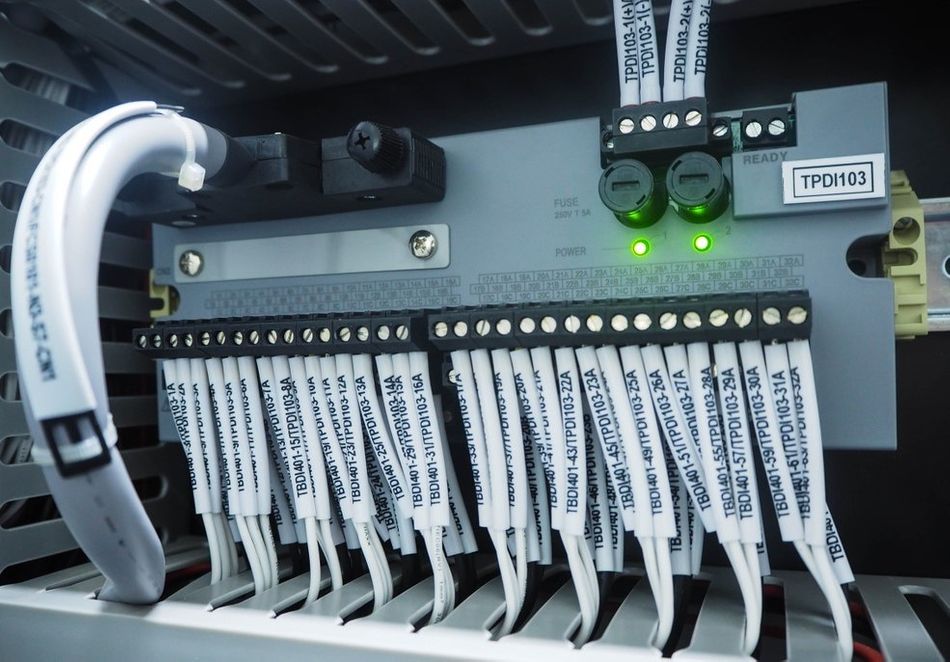
In oil refineries, DCS manages the entire production process, from crude oil distillation to final product blending. For instance, a DCS controls multiple distillation columns, monitoring and adjusting temperatures, pressures, and flow rates to optimize product yields. It also manages complex heat integration systems, maximizing energy efficiency across the plant.
Power generation plants rely heavily on DCS for boiler control, turbine management, and overall plant optimization. In a combined cycle power plant, the DCS orchestrates the intricate balance between gas turbines, heat recovery steam generators, and steam turbines. It manages critical parameters like fuel-to-air ratios, steam temperatures, and generator outputs to maintain optimal efficiency and grid stability.
The pharmaceutical industry utilizes DCS for bioprocess control in large-scale drug manufacturing. In a bioreactor facility, the DCS maintains precise control over pH levels, dissolved oxygen, temperature, and nutrient feed rates. It also manages the complex sequences involved in cell culture processes, ensuring consistent product quality across multiple batches.
Petrochemical plants employ DCS to control and optimize cracking furnaces, distillation columns, and reactor systems. The DCS manages the delicate balance of temperatures, pressures, and catalyst injection rates in ethylene production. This ensures maximum yield and product quality while maintaining safe operating conditions.
In the food and beverage sector, DCS is used in large-scale continuous processes such as dairy production. A milk processing plant might use DCS to control pasteurization, homogenization, and packaging operations. The system manages critical parameters like temperature profiles, holding times, and flow rates to ensure food safety and consistent product quality.
To illustrate the capabilities of DCS compared to PLCs in process control, consider the following table:
| Capability | DCS | PLC |
| Process Complexity | Handles Highly Complex, Interrelated Processes | Better Suited for Simpler, Discrete Processes |
| Scalability | Easily Scales to Thousands of I/O Points | Limited Scalability, Typically Hundreds of I/O Points |
| Control Strategies | Advanced Process Control, Model Predictive Control | Basic PID Control, Sequential Control |
| Data Management | Integrated Historian, Advanced Trending and Analysis | Limited Data Logging and Analysis Capabilities |
| Regulatory Control | Optimized for Continuous Control Loops | Better Suited for Discrete Control and Machine Logic |
| Integration | Seamless Integration with Plant Wide Systems (MES, ERP) | Often requires additional Middleware for Enterprise Integration |
| Operator Interface | Sophisticated HMI with Multi-Screen Support, Alarm Management | Basic HMI Capabilities, Often Single-Screen |
| Batch Management | Integrated Batch Control and Recipe Management | Limited Batch Capabilities, Often require Additional Software |
| Control System Security | Advanced Cybersecurity Features, Role-Based Access Control | Basic Security Features, Often reliant on Network Segregation |
DCS systems provide a comprehensive solution for process industries requiring tight integration between various plant subsystems. Their ability to handle complex control strategies, manage vast amounts of data, and provide plant-wide visibility makes them indispensable in large-scale continuous process environments.
DCS Programming: Function Blocks and Continuous Control
Distributed Control Systems (DCS) employ sophisticated programming approaches tailored for complex, continuous process control. The primary programming method in DCS is based on function block diagrams (FBDs), which provide a graphical representation of control strategies. [4] These function blocks encapsulate specific control algorithms, mathematical operations, or process functions, allowing engineers to build complex control schemes.
DCS programming typically involves the following key elements:
Function Block Programming: Engineers create control strategies by dragging and dropping pre-defined function blocks onto a canvas and connecting them to form a complete control loop. These blocks include PID controllers, mathematical functions, logic operations, and specialized process control algorithms.
Continuous Function Charts (CFC): An extension of function block diagrams, CFCs allow for more flexible arrangement and interconnection of function blocks, supporting complex control strategies and custom algorithms.
Sequential Function Charts (SFC): Used for batch processes and sequential control, SFCs define a series of steps, transitions, and actions that govern process flow.
Structured Text: A high-level programming language similar to Pascal, used for implementing complex calculations and algorithms that are difficult to represent graphically.
Custom Function Blocks: Many DCS platforms allow engineers to create custom function blocks, encapsulating complex logic or proprietary algorithms for reuse across the system.
Here's a visual example of a GD process control system in an industry:
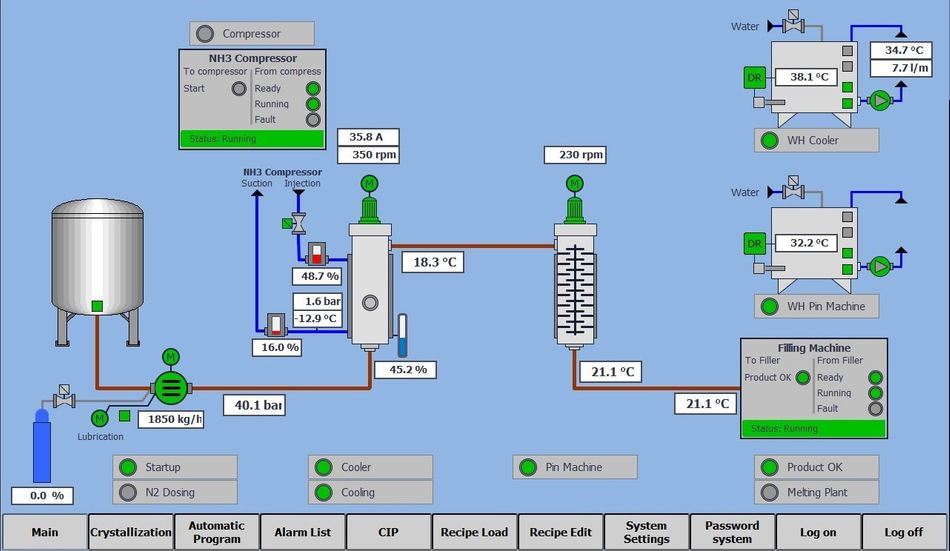
DCS programming offers several advantages in flexibility compared to traditional PLC programming:
Scalability: DCS programming is designed to handle large-scale processes with thousands of I/O points and complex interactions between multiple control loops.
Integrated Process Graphics: DCS programming environments often include tools for creating operator interface screens directly linked to the control logic, streamlining development, and maintenance.
Advanced Control Strategies: DCS platforms typically include libraries of advanced process control functions, such as model predictive control, adaptive tuning, and multivariable control, which are less common in PLC environments.
Centralized Configuration: DCS programming allows for centralized configuration and management of the entire control system, including controllers, I/O, networks, and human-machine interfaces.
Version Control and Change Management: DCS platforms often include robust tools for version control, change tracking, and project management, critical for large-scale process control applications.
Simulation and Testing: Many DCS programming environments include built-in simulation capabilities, allowing engineers to test and validate control strategies before deployment.
Flexibility in Control Hierarchy: DCS programming supports the creation of complex control hierarchies, including unit operations, equipment modules, and plant-wide optimization strategies.
While PLCs excel in high-speed, discrete control applications, DCS programming provides greater flexibility and integration for continuous process control, plant-wide optimization, and large-scale industrial operations. The object-oriented nature of function block programming allows for a more intuitive representation of process relationships and easier maintenance of complex control strategies. However, this comes at the cost of increased complexity and typically higher initial investment compared to PLC-based systems.
Recommended Reading: PLC Programming: A Comprehensive Guide to Mastering the Art of Automation
Performance Metrics: Speed, Reliability, and Scalability
Response Time and Scan Rates
Programmable Logic Controllers (PLCs) and Distributed Control Systems (DCS) exhibit significant differences in their response times and scan rates. This directly impacts their suitability for various industrial applications. PLCs typically operate with scan times in the range of 1-20 milliseconds, while DCS systems generally have scan times between 100-500 milliseconds. [5]
PLCs achieve faster scan times due to their simpler architecture and focus on discrete control tasks. The PLC CPU cyclically executes three main steps: reading inputs, executing the control program, and updating outputs. This rapid cycling allows PLCs to respond quickly to changes in discrete inputs, making them ideal for high-speed manufacturing processes, motion control, and safety-critical applications.
In contrast, DCS systems have longer scan times because they handle more complex, continuous processes with a larger number of variables and control loops. The distributed nature of DCS, with multiple controllers and extensive networking, introduces additional latency. However, DCS platforms often employ more sophisticated control algorithms that can compensate for longer scan times in numerous process control applications.
The impact of these differences is significant across various applications:
Discrete Manufacturing: PLCs excel in applications requiring rapid response, such as packaging lines or assembly robots, where millisecond-level control is crucial for precision and throughput.
Process Industries: DCS systems are well-suited for continuous processes like chemical plants or oil refineries. Slower dynamics of the processes align with longer scan times, while the focus remains on maintaining stable control over extended periods.
Motion Control: PLCs are preferred for applications involving precise motion control, such as CNC machines or conveyor systems, due to their ability to quickly process encoder feedback and adjust outputs.
Batch Processing: While DCS systems handle complex batch recipes effectively, PLCs might be chosen for smaller batch operations where rapid transitions between process steps are required.
Safety Systems: PLCs are often used in safety-critical applications due to their fast response times, crucial for emergency shutdowns or rapid fault detection.
Large-Scale Integration: DCS systems excel in applications requiring the integration of several I/O points and complex control strategies across an entire plant, despite their longer scan times.
Understanding these performance characteristics is crucial for engineers when selecting the appropriate control system for a given application. While PLCs offer superior speed for discrete control tasks, DCS systems provide the necessary integration capabilities for large-scale process control applications, despite their longer scan times.
Reliability and Redundancy
Reliability is paramount in industrial control systems, where downtime can result in significant financial losses or safety hazards. Both Programmable Logic Controllers (PLCs) and Distributed Control Systems (DCS) incorporate various reliability features, but their approaches differ in scope and implementation.
PLCs are designed for robustness in harsh industrial environments. They typically feature rugged construction, fanless cooling, and protection against electromagnetic interference. Many PLCs offer hot-swappable I/O modules, allowing for component replacement without system shutdown. Redundancy in PLCs is often implemented through dual redundant controllers. A primary controller operates the system while a secondary controller remains in standby mode, ready to take over in case of failure.
DCS systems, designed for large-scale process control, offer more comprehensive redundancy options. A typical DCS employs redundancy at multiple levels:
Controller Redundancy: Similar to PLCs, DCS uses redundant controllers, but often with more sophisticated failover mechanisms and seamless transitions.
Network Redundancy: DCS systems typically feature redundant communication networks, often using different physical paths to ensure continued operation in case of network failures.
Power Supply Redundancy: Critical components in a DCS are often equipped with redundant power supplies to mitigate the risk of power-related failures.
I/O Redundancy: DCS platforms may offer redundant I/O modules or channels for critical process variables.
Historian and Server Redundancy: Data historians and application servers in DCS environments are often configured in redundant pairs to ensure continuous data logging and system accessibility.
The key difference in redundancy between PLCs and DCS lies in the scale and integration of redundancy features. While PLCs typically focus on controller-level redundancy, DCS systems provide a more holistic approach to redundancy across the entire control architecture.
Critical reliability factors for industrial control systems include:
Mean Time Between Failures (MTBF): The average time a system operates before experiencing a failure.
Mean Time To Repair (MTTR): The average time required to repair a failed component or system.
Fault Tolerance: The system's ability to continue operating in the presence of component failures.
Environmental Resilience: Resistance to temperature extremes, vibration, dust, and electromagnetic interference.
Power Quality Management: Ability to handle power fluctuations and maintain operation during brief power interruptions.
Cybersecurity Features: Protection against unauthorized access and cyber threats.
Diagnostic Capabilities: Built-in system health monitoring and fault detection mechanisms.
Backup and Recovery: Robust data backup systems and efficient recovery procedures.
Scalability: Ability to expand the system without compromising reliability.
Vendor Support and Spare Parts Availability: Long-term support and readily available replacement components.
These reliability factors are crucial considerations when designing and implementing industrial control systems. While both PLCs and DCS systems address these factors, the extent and method of implementation can vary significantly based on the scale and criticality of the application. Engineers must carefully evaluate these reliability features in the context of their specific industrial requirements to ensure optimal system performance and minimal downtime.
Recommended Reading: What is a PLC (Programmable Logic Controller): A Comprehensive Guide
Scalability and System Expansion
Scalability is a critical factor in industrial control systems, determining their ability to adapt to growing production needs and evolving process requirements. Programmable Logic Controllers (PLCs) and Distributed Control Systems (DCS) differ significantly in their approach to scalability and system expansion.
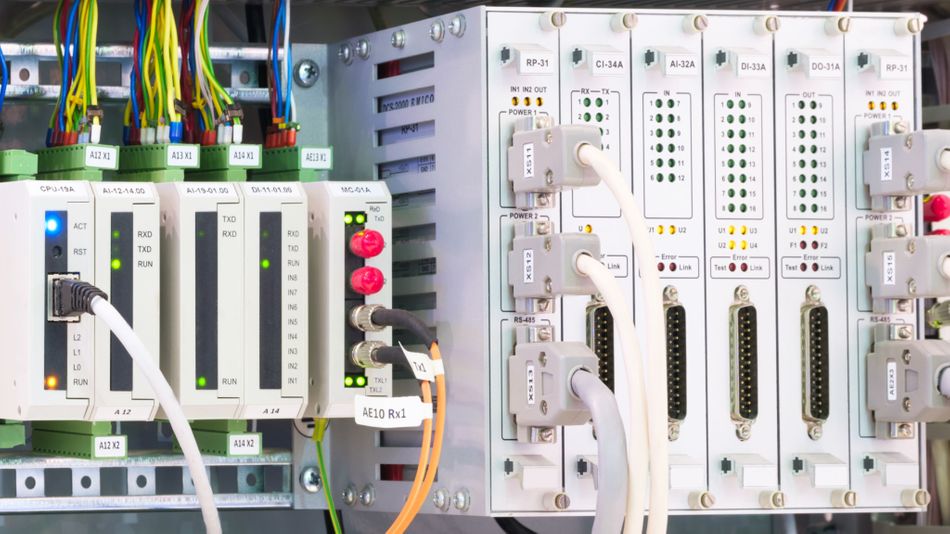
PLCs are designed with modularity in mind, allowing for incremental expansion of I/O capacity and processing power. Typical PLC systems can be scaled by adding I/O modules to the existing rack or by connecting remote I/O racks. For larger expansions, PLCs can be networked together, creating a distributed control architecture. However, as the system grows, managing the increased complexity of inter-controller communication and maintaining consistent scan times across multiple PLCs can become challenging.
PLC scalability is often limited by factors such as:
I/O Capacity: Restricted by controller limitations.
Network Bandwidth: Impacts communication between PLCs.
Programming Complexity: Increases with system size.
Memory Constraints: Limits program size and data storage.
DCS systems, on the other hand, are inherently designed for large-scale operations and offer more seamless scalability. They handle increasing I/O points and control loops through a distributed architecture where multiple controllers share the processing load. DCS platforms typically provide:
Modular Architecture: Easy expansion with controllers and I/O.
Load Balancing: Efficient resource utilization.
Centralized Management: Simplified system administration.
Advanced Networking: Handles high data volumes effectively.
When expanding a DCS, engineers can add new controllers, I/O subsystems, or entire process units without disrupting existing operations. The system's architecture allows for easy integration of new components, with the central engineering and operator interfaces automatically recognizing and incorporating the additions.
The scalability of DCS also extends to its software architecture. DCS platforms often provide advanced features like:
Dynamic Resource Management: Automatic allocation and load balancing.
System Integration: Seamless integration of third-party systems.
High Availability: Built-in redundancy and fault tolerance.
Data Handling: Advanced alarm management and historicization.
In contrast, scaling PLC systems to very large sizes often requires careful planning and custom integration work to maintain system performance and manageability. While PLCs excel in smaller, discrete control applications, DCS systems provide a more robust framework for large-scale, integrated process control and plant-wide automation.
Integration and Connectivity: From Shop Floor to Top Floor
Network Protocols and Communication
Industrial control systems rely on robust communication protocols to ensure seamless data exchange between various components and higher-level systems. PLCs and DCS systems employ a range of protocols, each tailored to specific communication needs within the industrial environment.
Common communication protocols in PLC systems include:
Modbus: A simple, open protocol widely used for device-to-device communication.
EtherNet/IP: Based on standard Ethernet, it's popular for its compatibility with IT infrastructure.
Profinet: Developed by Siemens, it offers real-time capabilities for industrial automation.
DeviceNet: A CAN-based protocol for connecting industrial devices.
OPC UA: A platform-independent protocol for secure data exchange.
DCS systems often utilize more advanced protocols, including:
Foundation Fieldbus: Designed for process control applications, offering deterministic communication.
HART (Highway Addressable Remote Transducer): Enables digital communication over existing 4-20mA analog wiring.
Profibus: A Fieldbus protocol for high-speed data communication in process automation.
OPC UA: Increasingly adopted in DCS for its interoperability and security features.
Proprietary Protocols: Many DCS vendors offer their own optimized communication protocols.
Integration with higher-level systems differs between PLCs and DCS:
PLC Integration:
PLCs often require additional middleware or OPC servers to connect with SCADA systems.
Integration with MES (Manufacturing Execution Systems) typically involves custom programming or third-party software.
Data historians may need separate configurations to collect data from multiple PLCs.
DCS Integration:
DCS platforms usually offer built-in SCADA functionality, eliminating the need for separate systems.
MES integration is often more streamlined, with DCS providing direct interfaces or pre-built connectors.
Historian capabilities are typically integrated into the DCS architecture, facilitating easier data collection and analysis.
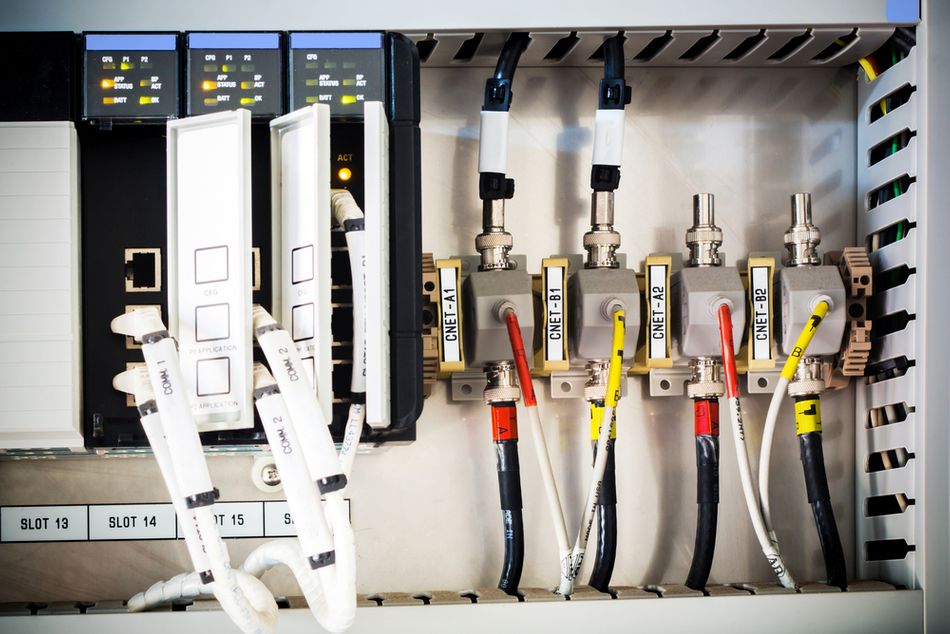
The PLC system often requires intermediate layers (like OPC servers and SCADA) for higher-level integration. On the other hand, DCS system provides a more integrated approach with built-in functionalities for plant-wide control and data management.
Recommended Reading: Modbus TCP: A Comprehensive Guide to the Protocol and Its Applications
Data Management and Analytics
Programmable Logic Controllers (PLCs) and Distributed Control Systems (DCS) differ significantly in their approach to data management and analytics. This reflects their distinct architectural designs and primary application areas.
PLC Data Handling: PLCs traditionally focus on real-time control and have limited built-in data storage capabilities. Typical PLC data management features include:
Cyclic data logging of process variables
Limited historical data storage (often hours to days)
Basic trending and alarm logging
Data export to external databases or historians
To enhance their data handling capabilities, PLCs often rely on external systems such as:
SCADA software for extended data logging and visualization
Separate historian databases for long-term data storage
OPC servers to facilitate data exchange with higher-level systems
DCS Data Handling: DCS platforms are designed with comprehensive data management as a core feature. They typically offer:
Integrated historian functionality with years of data storage capacity
Advanced data compression and retrieval algorithms
Real-time and historical trending with multiple time scales
Sophisticated alarm management and event logging
Built-in reporting tools and data analytics functions
IIoT and Industry 4.0 Support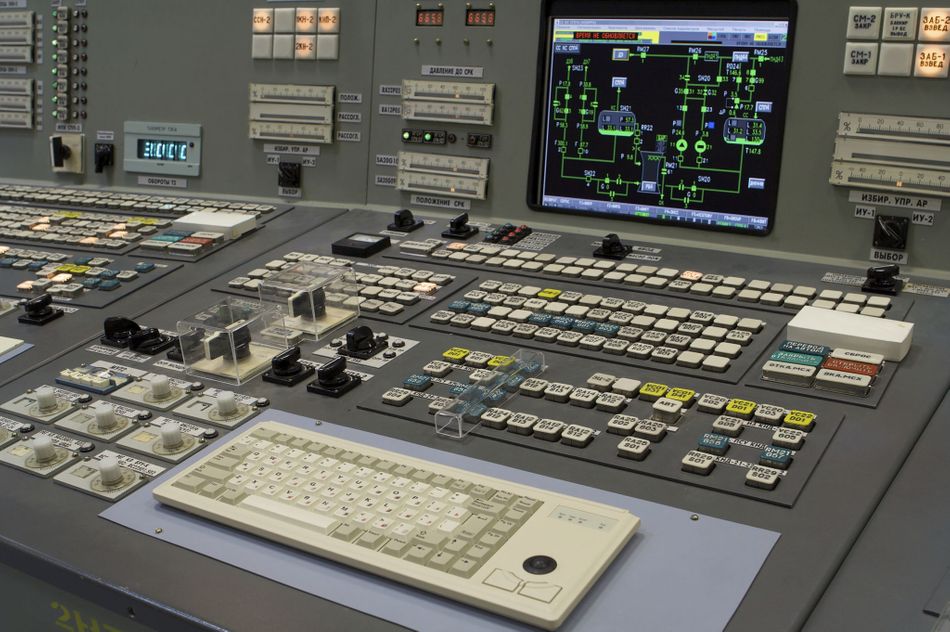
PLC Systems: PLCs are adapting to IIoT and Industry 4.0 requirements through:
Integration of Ethernet-based communication protocols (e.g., MQTT, OPC UA)
Edge computing capabilities in newer PLC models
Cloud connectivity options for remote monitoring and data analysis
Partnerships with IIoT platform providers for enhanced analytics
Example: A modern PLC might use MQTT to publish key performance indicators to a cloud-based analytics platform, enabling real-time production monitoring and predictive maintenance alerts. [6]
DCS Systems: DCS platforms are well-positioned for IIoT and Industry 4.0 initiatives, offering:
Native support for IIoT protocols and cloud integration
Scalable architectures that can incorporate edge computing nodes
Advanced cybersecurity features for data protection
Integrated analytics engines for on-premise and cloud-based data processing
Example: A DCS might leverage its integrated historian and analytics engine to perform real-time process optimization, automatically adjusting control parameters based on machine learning algorithms running on the plant floor.
While PLCs are evolving to meet the data demands of modern manufacturing, DCS systems generally offer more comprehensive and integrated solutions for data management and advanced analytics. The choice between PLC and DCS for data-driven applications depends on factors such as the scale of operations, the complexity of analytics required, and the level of integration needed with enterprise-wide systems.
Recommended Reading: The Engineer's Guide to Industrial IoT and Industry 4
Conclusion
The choice between PLC and DCS depends on a comprehensive evaluation of process requirements, system scale, budget, and future goals. While PLCs excel in discrete control applications, DCS systems provide a comprehensive solution for complex, continuous processes. By understanding the core differences and considering long-term objectives, businesses can select the optimal automation solutions to drive efficiency, productivity, and profitability.
Frequently Asked Questions
Q: What is the main difference between PLC and DCS in terms of control architecture?
A: PLCs use a centralized control architecture where a single processor manages all control functions. On the other hand, DCS employs a distributed architecture with multiple controllers spread across the facility, each responsible for specific process areas.
Q: How do PLC and DCS differ in terms of scalability?
A: PLCs are typically limited to handling hundreds to a few thousand I/O points and are best suited for smaller, discrete control applications. DCS can easily scale to manage tens of thousands to millions of I/O points, making them ideal for large-scale, integrated process control systems.
Q: What are the key differences in programming between PLC and DCS?
A: PLCs primarily use ladder logic, function block diagrams, and structured text for programming. DCS systems offer more advanced programming options, including high-level languages, graphical function block programming, and integrated development environments for complex control strategies.
Q: Which industries typically use PLCs, and which prefer DCS?
A: PLCs are commonly used in discrete manufacturing, automotive, packaging, and material handling industries. DCS is prevalent in process industries such as oil and gas, chemicals, pharmaceuticals, power generation, and large-scale food and beverage production.
Q: What are the cost implications of choosing between PLC and DCS?
A: PLCs typically have lower initial costs and are more cost-effective for smaller applications. However, scaling PLC systems for larger operations can incur significant integration costs. DCS systems have higher upfront costs but offer more integrated and cost-effective solutions for large-scale operations in the long run.
References
[1] Control. Understanding Centralization vs Decentralization of PLCs [Cited 2024 August 9] Available at: Link
[2] Control. Introduction to Distributed Control Systems (DCS) [Cited 2024 August 9] Available at: Link
[3] ResearchGate. Cleaning in Place (CIP) in Food Processing [Cited 2024 August 9] Available at: Link
[4] Control. PLC Programming With Function Block Diagrams [Cited 2024 August 9] Available at: Link
[5] Siemens. White Paper: DCS or PLC? - Digital Asset Management [Cited 2024 August 9] Available at: Link
[6] HIVEMQ. Real-Time Production Monitoring with MQTT and Edge Analytics [Cited 2024 August 9] Available at: Link
Table of Contents
IntroductionThe Architectural Divide: PLC and DCS at Their CoreCentralized vs Distributed ControlComponent BreakdownFunctionality Face-off: Applications and Use CasesPLC's Domain: Discrete Control and Machine AutomationDCS Territory: Process Control and Plant-wide IntegrationDCS Programming: Function Blocks and Continuous ControlPerformance Metrics: Speed, Reliability, and ScalabilityResponse Time and Scan RatesReliability and RedundancyScalability and System ExpansionIntegration and Connectivity: From Shop Floor to Top FloorNetwork Protocols and CommunicationData Management and AnalyticsConclusionFrequently Asked QuestionsReferences